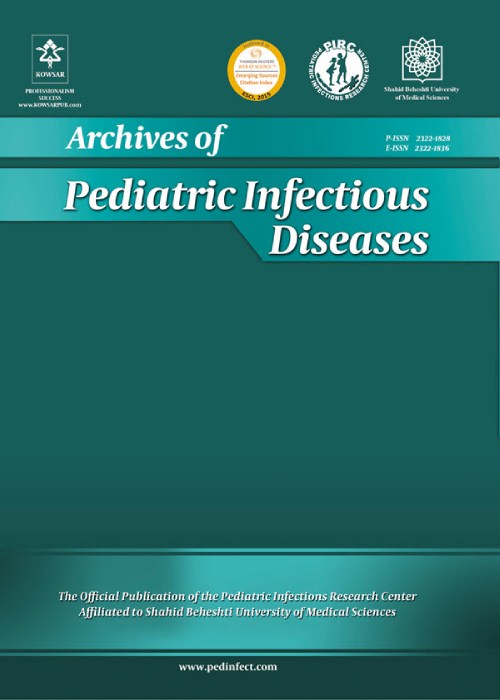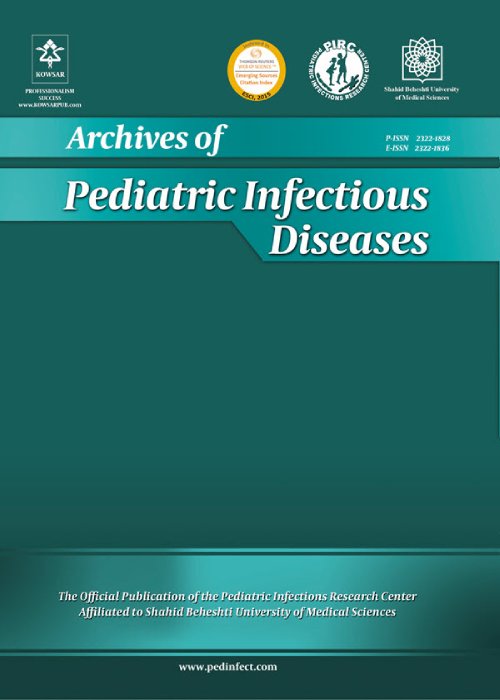فهرست مطالب

Archives of Pediatric Infectious Diseases
Volume:11 Issue: 4, Oct 2023
- تاریخ انتشار: 1402/08/23
- تعداد عناوین: 6
-
-
Page 1Background
This study aimed to examine the correlation between the pediatric assessment triangle (PAT) and the rate of hospitalization among pediatric patients. Patients presenting to the pediatric emergency department were categorized based on PAT criteria during the study period, and retrospective data analysis was conducted. The primary outcome measure was the percentage of patients with PAT findings who required hospital admission; however, the secondary outcome measure focused on the association between PAT findings and admission to the pediatric intensive care unit (PICU) and the comparison between hospitalization rates with disrupted PAT versus blood testing as the initial diagnostic step.
MethodsIn this study, 622 patients were enrolled, and among them, 246 patients (39.5%) had normal findings in the peripheral arterial tonometry (PAT) test. The researchers conducted both univariate and multivariate analyses to investigate the relationship between PAT results and hospitalization. They also examined the association between hospitalization and abnormal findings in more than one component of PAT, presentation at the emergency department, performance of blood tests showing abnormalities in more than one component, and appearance while accounting for potential confounding factors. By adjusting for these confounders, the researchers aimed to assess the independent impact of PAT on hospitalization risk and identify any significant associations.
ResultsThe study revealed a strong association between impaired PAT findings and hospitalization, both in univariate and multivariate analyses. Abnormal findings in >1 component of PAT, appearance in the emergency department, and abnormal findings in >1 component of blood tests were the most significant factors related to hospitalization, even after adjusting for confounders. Conversely, normal PAT findings showed no association with either the primary or secondary outcomes. Furthermore, hospitalization rates differed significantly between patients with impaired PAT and those with normal PAT.
ConclusionsImpaired PAT findings, when utilized by pediatricians, are associated with increased hospitalization rates, even during the peak of the coronavirus disease 2019 (COVID-19) pandemic. Moreover, it is crucial to emphasize physician training in utilizing PAT effectively as the initial step in evaluating pediatric patients in the emergency room, potentially reducing the need for additional costly testing and enabling physicians to make more confident decisions.
Keywords: Pediatric Assessment Triangle (PAT), Pediatric Emergency Department (PED), Hospitalization -
Page 2Background
Severe acute respiratorysyndromecoronavirus 2 (SARS-CoV-2) has led to the recent pandemic. According to published reports, respiratory symptoms, such as pneumonia and inflammatory conditions, are common in this disease.
ObjectivesThe current study aimed to investigate the level of antiphospholipid (aPL) antibodies in children with and without coronavirus disease 2019 (COVID-19).
MethodsThis descriptive-analytic cross-sectional study was conductedon patients under 16 years of age with and without COVID-19 admitted to Ali Asghar Hospital between December 2021 and February 2022. Patient information was collected by the researcher in a checklist. The checklist included demographic information, clinical findings, and information on laboratory and ultrasound results.
ResultsIn this study, 99 patients were evaluated in three groups: control (without COVID-19), moderate, and severe. The means (standard deviation [SD]) of C-reactive protein (CRP) and D-dimer were significantly higher in the severe group. The Pearson correlation coefficient test was used to examine the relationship between aPL and anticardiolipin (aCL) antibodies with laboratory results. The only significant and direct relationship was observed between aCL antibody and D-dimer.
ConclusionsIncreased CRP and D-dimer in children with COVID-19 are associated with the severe form of this serious disease. However, there was no significant association between the severity of the disease and the levels of aCL and aPL antibodies and anti-beta 2-glycoprotein I antibodies (a 2GPI) in children.
Keywords: Children, COVID-19, Antiphospholipid Antibody -
Page 3Background
Coronavirus disease 2019 (COVID-19) hasbecomea worldwide issue due to its high prevalence and rapid transmission. Fungal infections have been detected in COVID-19 patients, leading to increased morbidity and mortality.
ObjectivesThis study aimed to isolate Aspergillus fumigatus and Mucor spp. on mini-bronchoalveolar lavage samples obtained from children with COVID-19 hospitalized in an Iranian children’s hospital.
MethodsA cross-sectional descriptive study was performed on mini-bronchoalveolar lavage samples from children confirmed positive for COVID-19 admitted to ICU with a ventilatorfromApril 2021 to February 2022. Demographiccharacteristics were recorded, and fungal DNA was extracted from mini-BAL samples taken from children. Nested PCR was made with two primers for Aspergillus fumigatus and Mucor spp.
ResultsOut of 100 children with COVID-19, all samples were negative for Aspergillus fumigatus; however, 12 cases were positive for BAL PCR for Mucor spp. Among the 12 patients, fever, shortness of breath, cough, and decreased level of consciousness were reported in 8.3% (n: 1), 16.6% (n: 2), 25% (n: 3), and 25% (n: 3), respectively. Most cases (41.7%; n: 5) suffered from heart disease, followed by underlying malignancy (33.4%; n: 4). All positive BAL PCR for Mucor spp. cases had significantly higher chest CT scan scores and spent more time under a ventilator.
ConclusionsThe identification of COVID-19 with Mucor spp. was observed among 12% (n: 12) of children hospitalized in a COVID-19 ICU. When dealing with pediatric COVID-19 patients, clinicians should consider the differential diagnosis of fungal co-infections and have a low threshold to begin treatment. Moreover, it is highly advisable to take prophylactic measures, such as properly using corticosteroids and shortening the intubation time.
Keywords: Aspergillosis, COVID-19 Identification, Mucormycosis, Paediatrics -
Page 4Background
Congenital cytomegalovirus (cCMV) is the most common intrauterine viral infection, affecting up to 2.5% of live births worldwide; it is also the most common non-hereditary cause of sensorineural hearing loss (SNHL) in infants.
ObjectivesThis study aimed to evaluate the frequency of cCMV and the incidence of sensorineural hearing loss at a large referral hospital in Tehran.
MethodsIn our cross-sectional study, all infants born between March 2019 and April 2020 (one year) at Mahdiyeh Obstetrics and Gynecology Hospital were enrolled in the present study, and their urine samples were collected forCMVPCR in the first 2 days of life. PCR test results divided these infants into two groups, with and without congenital cytomegalovirus infection. For both groups, the otoacoustic emission screening test (OAE) was performed at birth and one month of age; the auditory brain response test (ABR) was then performed for infants with hearing impairment.
ResultsUrine samples of 859 were collected for cytomegalovirus PCR testing; 70.3% of specimens were from male infants. Neonatal urine samples were tested for the presence of cytomegalovirus by PCR; 847 of the specimens (98.6%) were negative, and 12 (1.4%) were positive for cytomegalovirus, CI: (95%). The prevalence of congenital cytomegalovirus infection was 1.18% in girls and 1.49% in boys, revealing no significant difference between the two groups. All infants with congenital cytomegalovirus infection were full-term, between 38 and 42 weeks of gestational age. The first OAE test was impaired in 4 cases (33%) with congenital cytomegalovirus infection.
ConclusionsIn our study, congenital CMV infection prevalence was 1.4%. We recommend hearing screening tests (OAE and AABR) be performed for all neonates. If impaired, the infant should also be evaluated for cCMV infection in addition to auditory follow-up. It is recommended that this study be continued in a multicenter manner with a larger number of samples and a longer period to fully evaluate the prevalence of complications in cCMV.
Keywords: Congenital Cytomegalovirus Infection, Newborn Screening, Sensorineural Hearing Loss -
Page 5Background
Antibiotics should be used to treat bacterial infections, while prescribing antibiotics for viral infections is ineffective. Sometimes, physicians do not diagnose diseases correctly and misdiagnose viral infections as bacterial.
ObjectivesIn this study, we aimed to evaluate the appropriateness of prescribed antibiotics in the Children’s Emergency Department of Mofid Hospital, Tehran, Iran.
MethodsThis cross-sectional study was conducted in the Emergency Department of Mofid Children’s Hospital during January-December 2019. All children younger than 16 years who were hospitalized and received antibiotics were included in this study. The degree of fever, diagnosis of disease, and laboratory findings were assessed.
ResultsWe found 12.6% (38/301) inappropriate antibiotic prescriptions in the studied cases. The causes of antibiotic inappropriateness were incorrect diagnosis in 4.31% of patients (13/301), incorrect medication dose in 1.99% (6/301) patients, and no indication for the prescribed medicine in 6.31% (19/301) patients. Erythrocyte sedimentation rate, C-reactive protein, and neutrophil count were not significantly different between the two groups (P > 0.05).
ConclusionsAccording to our results, incorrect antibiotic prescription is common in Mofid Hospital. Therefore, it is an urgent need to monitor and train the treatment system.
Keywords: Antibiotic, Appropriateness, Emergency, Children -
Page 6Introduction
Enterobacter sakazakii is considered a rare yet extremely important cause of enterocolitis and may lead to a necrotizing condition. Central nervous system and blood infections with this type of organism will be fatal, with a mortality rate of as much as 40 - 80%.
Case PresentationOur case report is a 31-month-old boy with a history of posterior urethral valves surgery presented to the emergency department with a history of dysuria, dribbling, and a 24-hour history of fever, chill, and anorexia. The case had a urinary tract infection diagnosis with E. sakazakii.
ConclusionsE. sakazakii can cause bacteremia, meningitis, and necrotizing enterocolitis, but E. sakazakii causes rare literature about urinary tract infection (UTI).We have reported a rare Enterobacter sakazakii infection in the present study.
Keywords: Child, Urinary Tract Infection, Enterobacter sakazakii, Case Report


